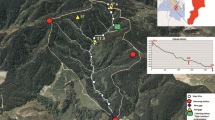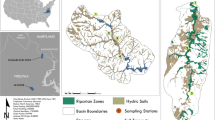Abstract
Water samples have been collected from two forested catchments in the Slavkovsky les Mountains of western Bohemia, in the Czech Republic. The objective of the study was to compare and contrast elemental fluxes in two catchments with similar conditions of climate, topography, vegetation over and acidic atmospheric deposition, but very different bedrock geology. The Lysina catchment is underlain by slow-weathering leucocratic granite. Soils are podzolized brown earths and peaty gleys with small pools of exchangeable basic cations. Both soils and drainage water at Lysina are acidified by atmospheric deposition. Surface runoff was found to be dominated by sulphate and dissolved silica, accompanied by high concentrations of H+ (volume weighted pH = 3.87). Stream water also displayed extremely high concentrations of total aluminum (volume-weighted mean 66 μmol.l−1). Inorganic monomeric aluminum was the predominant aluminum fraction present, which contained mainly aquo-Al (Al3+ and fluoride complexes.
The Pluhuv Bor catchment is characterized by ultramafic serpentinite and, in contrast to Lysina, soil and drainage waters have higher concentration of basic cations. Streamwater chemistry was dominated by magnesium, sulphate and silica. Stream-water at the site was not acidic (volume weighted pH = 7.25). The ratio of output/input of sulphate was similar at both catchments (1.16 for granite site and 1.07 for the serpentinite site). This pattern may be indicative of the conservative behaviour of sulphate in very different soil and bedrock environments under elevated loadings of acidic deposition.
Resume
(pH = 3.87). Les eaux de la rivière présentent en outre des teneurs particulièrement élevées en aluminium total (66 µmol.l−1). L'aluminium domine sous la forme d'un monomère minéral, surtout l'aluminium aqueus (Al3+) et des complexes fluorés.
Le bassin de la Pluhuv Bor est caractérisé par une serpentinite ultrabasique et, au contraire de la Lysina, par des sols et des eaux de drainage à très fortes teneurs en cations basiques. Les eaux de la rivière sont dominées par le magnésium, les sulfates et la silice. Ces eaux ne sont pas acides (pH = 7.25). Le rapport des flux de sortie et d'entrée de sulfates est identique pour les deux bassins (1.16 pour le bassin granitique; 1.07 pour le bassin de serpentinite). Cette situation parait signifier que les sulfates présentent un comportement conservatif dans des environnements pédologiques et géologiques très différents, sous des apports acides importants.
Similar content being viewed by others
Author information
Authors and Affiliations
Rights and permissions
About this article
Cite this article
Krám, P., Hruška, J. Influence Of Bedrock Geology On Elemental Fluxes In Two Forested Catchments Affected By High Acidic Deposition. HYJO 2, 50–58 (1994). https://doi.org/10.1007/s100400050048
Published:
Issue Date:
DOI: https://doi.org/10.1007/s100400050048




